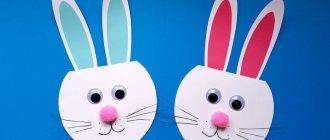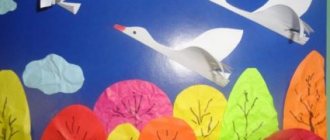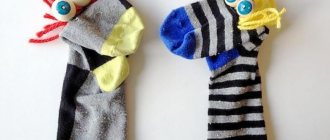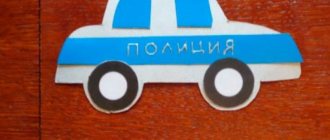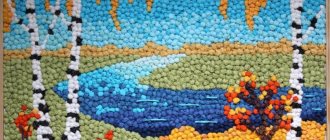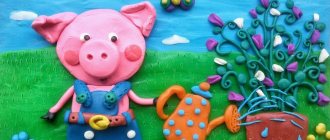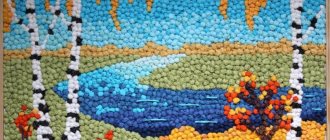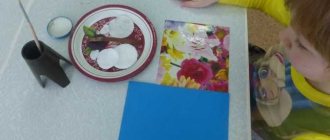Required materials and tools
Even the smallest kids can make an applique out of paper, but with the help of adults. To implement such a craft, you need to show your personal imagination, or use ready-made instructions for children. You will also need some materials and tools:
- Cardboard (white or colored depending on the child’s wishes);
- Simple pencil (for sketching);
- Colored paper (single-sided, double-sided, velvet or corrugated is suitable);
- Glue for paper (for younger children, a glue stick is more suitable, but with PVA glue you should be careful not to spread it too much and thereby ruin the entire craft);
- Scissors (necessarily with rounded ends due to safety precautions);
- Felt-tip pens and markers (for additional decoration of the created work, since with the help of a little drawing of details, the application can sparkle with new colors and become more attractive).
Examples for the younger group
The leading place among handicraft lessons for children 2-3 years old on the topic of vegetables is canning.
At the preparatory stage, it is worth discussing with the children what vegetables they would like to see in their future creations.
After that, they can independently choose what they have voiced among pre-prepared templates and glue it to the base. A jar cut out of cardboard is suitable for it.
Examples for the middle group
From the age of three, children develop basic skills in using scissors. In this regard, you can complicate the tasks a little. A variety of themes using vegetables will work. This is both canning and a basket with the harvest.
For the second theme, you will need pre-prepared cardboard bases in the shape of baskets. If they are cut out of white cardboard, then it would be appropriate to invite the children to draw a pattern on them themselves. At the second stage, it is worth having a conversation on the topic of vegetables. A short description of each would be appropriate: its shape, color. It would also be useful to discuss their taste and beneficial properties.
For demonstration, you can show real vegetables brought from home. If you let babies touch them, they will also be able to feel and feel their texture.
After the introductory conversation, you can start cutting. It is worth once again focusing on shapes and sizes. To make the task easier, you can draw a sketch with a pencil.
It is worth understanding that few children at this age will be able to cut clearly along the contour. But despite this, a children's applique with figurative images can be assembled. In the next step, all that remains is to arrange all the blanks the way the child wants. And stick them with glue. Still life according to the master class for beginners is ready.
Lesson “Applique “Zayushkin’s vegetable garden””
Municipal budgetary preschool educational institution "Kindergarten No. 12"
Application "Zayushkin's vegetable garden"
Compiled by: Efremova Yu.V.
G. Chernushka, 2021
Tasks.
Teach children to highlight actions.
Teach children to create an applique of images of vegetables: carrots by cutting a rectangle diagonally and rounding the corners, cabbage by tearing them off and applying an applied applique.
Arouse interest in the collective composition “Zayushkin’s vegetable garden.”
Develop an interest in working together.
Preliminary work.
Examination and examination of vegetables (real or high-quality dummies); modeling cabbage and carrots in the previous lesson.
Materials, tools, equipment.
Hare (soft toy). Orange paper rectangles for cutting out carrots, dark green paper ovals and light green squares for cabbage forks; unfinished composition “Zayushkin's vegetable garden”, brown rectangles made of paper beds, scissors, glue, glue brushes, paper and cloth napkins, oilcloths. Carrots and cabbage are real fruits or high-quality dummies for demonstration in class.
Basic diagrams for planning work for children:
— “Carrot”: an orange rectangle, cut into two triangles, to one of which a tail of torn pieces of green paper is glued;
- "cabbage" a dark green oval and a light green square, torn into pieces; two or three of which are glued to the oval - cabbage forks.
- “Bed” is a brown rectangle, cabbage is glued to it in two rows and a second rectangle, where carrots are glued in a fan;
Contents of the lesson.
Motivation
IN
A toy hare comes to visit the children and offers to listen to a story. The teacher reads B Lagzdyn’s poem “Bainki, bunny”.
- Bainki, bainki,
Where did the bunnies work?
- We weeded the beds,
Everything is in order now: Where is the carrot, oh trouble! Quinoa is thriving!
- Goodbye, goodness! Where did you play, little bunnies?
- We played hide and seek, Everything is in order now; Where are the cabbage stalks, there are roots left!
- Goodbye, goodness! Where were you walking, little bunnies? “We didn’t go out today, they tore our ears for something.” - Bunnies, bunnies! Go to bed, my dears...
On behalf of the toy hare, the teacher asks the children what happened in the garden and why the hares were pulled by the ears. The teacher offers to please the bunnies by making a lot of delicious carrots and cabbage for them. She shows the children the beds next to the unfinished composition “Zayushkin’s vegetable garden.” Each group has a part of the large “Zayushkin’s garden”.
Goal setting.
Guys, look how many beds the hare has, and the beds with cabbage and carrots need to be done in a few minutes, since the hare must run to the hare with her cubs and protect them from the wolf and the fox. I can't handle this kind of work alone. Can you help me?
Draws the children’s attention to the prepared materials and asks what we will cut the carrots from. Children find orange paper rectangles on their tables and show them.
The teacher takes his orange rectangle, cuts it diagonally into two triangles and rounds the corners on them to make two carrots.
Then he takes a dark green paper oval and a light green square; tears the square into pieces, slightly crumples it and glues it onto an oval, depicting cabbage forks: the “leaves” are not glued solidly (tightly), but only with the lower part and lightly overlap each other. Use leftover green paper to make a fluffy tail for a carrot.
Places applicative carrots and cabbage on the beds from the unfinished composition “Zayushkin’s vegetable garden.” Invites children to admire. He says that the bunnies were very happy and can’t wait for all the children to prepare a treat for them.
Planning
.
The teacher clarifies the task: cut two carrots from an orange rectangle (shows the workpiece and gestures to remind the direction of the diagonal cut line) and fold cabbage forks on a paper oval (shows) from torn leaves (shows a square and tears a corner), shows how There are carrots on the bed (in a fan), the second bed with cabbage arranged in two rows. Provides support diagrams (3 pieces) for teaching children how to plan work.
Motivation for unification
What do we have to do? (carrots and cabbage and stick their beds, and the beds onto the garden). So the first operation is to cut the carrots, and the second operation is to make the cabbage. And the third operation is to glue the beds for vegetables and the vegetables themselves.
Let's see how many operations we got? (three)
So how many people will we unite? (three each)
What scheme should you rely on, who will make the carrot?
What scheme will help those who will make cabbage?
What scheme should be used when preparing beds with vegetables?
The guys who will make vegetables bring it to the person who makes the beds in your group, bring your finished vegetables to him for gluing.
What do you need to take for the first operation? (scissors, orange rectangle, markers)
What will you need to take for the second operation? (green oval, light green square, glue)
What about the third operation? (brown rectangle and glue)
Then we choose a couple for ourselves (the children choose themselves). Then this couple chooses another partner to work with.
Specifying a group goal
Katya, what will you do? And you Sonya? And you Vanya?
(Ask each group)
Desk organization
Now go to the tables and take everything you need for work and you can get to work
Carrying out activities
The children do the work. When ready, children move their carrots and cabbage to the beds. The one who makes the beds glues them to his part of “Zayushkin’s garden”.
Result evaluation
Have you got a vegetable garden? Did you easily agree on who will do what? Tell me, was it good for you to work together?
Reflection
At the end of the lesson, the toy hare rejoices with the children about how beautiful and “tasty” their garden is.
After class.
Completion of the design of the collective composition “Zayushkin’s vegetable garden”.
Examples for the older group
For older children, the application becomes more complicated due to the additional use of mosaics or adding volume. The following will demonstrate step-by-step instructions on how to make a vegetable applique in the tear-off style.
This craft looks unusual and provides the child with the opportunity to break out of the strict boundaries of cutting.
- A sheet of cardboard is used as a basis. On it, using a simple pencil, you can draw the silhouettes of any vegetables that you would like to see in your work.
- Take paper of the colors that are characteristic of the selected vegetables. For carrots - orange, for potatoes - brown, for tops - green, and so on. Each leaf is manually torn into small squares.
- The resulting pieces fill the space in the sketches. And they are glued on with glue.
- Ready!
Such work will look no less beautiful, but more accurately, if the parts for the mosaic are not torn by hand, but cut with scissors.
A voluminous craft is a little more difficult to make, but children can easily cope with it if they put in a little effort. Thus, a voluminous carrot can be created by folding a long orange strip of paper in half. Form a sharp corner on one side and leave the joint rounded on the opposite side. To which the green tail will remain glued.
You can also use another method. To do this, you need thick paper or cardboard rolled into a cone. Then cover the top with orange crepe paper.
And cover the round hole with green paper, in the center of which several short strips of green crepe paper will remain glued.
Carrot giraffe
This cute and easy-to-make giraffe will not leave anyone indifferent. Instead of carrots, you can use potatoes.
For this craft we need two large unequal carrots, toothpicks and three matches.
- From part of the larger carrot we make the body, from the remaining carrot we cut out the legs, from the smaller carrot we cut out the head and neck;
- We attach the neck and legs to the giraffe’s body with ordinary toothpicks. We attach the tail from the back; for this we use one of the prepared matches. This should be done so that only the head and very little straw remain visible;
- We cut out the head from the remaining part of the carrot and attach it to the neck with a toothpick. We also make horns from matches. Giraffe ears can also be cut from carrots, or you can get by with just the horns;
- The eyes can be easily made from cereals (for example, buckwheat) or pressed in with ordinary black beads. Giraffe spots can be easily made from paper or plasticine.
Related article: DIY wedding decoration made from beads with photos
Our cute giraffe is ready!
Recommendations for Improving Collaboration
- When learning how to applique vegetables, it is important to follow each step consistently.
- It’s worth preparing all the required materials and templates in time so that you don’t have to be distracted by collecting what you need later.
- At the time of preparatory work, it is of considerable importance to familiarize children with works of art, as well as demonstrate drawings and photos of vegetable appliqués.
- With children, conducting classes in the form of a game is more suitable, since this way the children’s attention is drawn to what is happening and thereby develops emotional responsiveness.
- Adults should create a small plan so as not to lose track of the sequence of actions. Older children can follow the steps themselves.
- It is worth giving young creators more independent work so that they can express their imagination and learn how to realize it.
- During independent work, an adult is obliged to help the children, especially those who are not doing well.
- Upon completion of all the work, it is advisable to hold a collective exhibition, when everyone can look at someone else’s work and thus learn to enjoy the results of their own and other people’s work.
- In addition to individual work, the proposed ideas can also be implemented in group work, when everyone cuts out their own vegetable and glues it onto a large common base in the form of a plate, pan or cup.
- This approach is suitable for many applications. Especially on the topic of fruits.
Edible basket
To make a basket with vegetables, we will need a large pumpkin for the basket itself, as well as various vegetables and fruits to fill it.
Why is pumpkin the best choice for a basket? Because it has a strong peel, and thanks to this the basket will keep its correct shape and will not deteriorate for a long time. In addition, pumpkin is a very pliable material that can be easily handled by a child.
So, let's get to work:
- First you need to carefully inspect the pumpkin for damage;
- Wash the pumpkin thoroughly and wipe dry with a towel;
- Next, you need to attach the prepared template for the handle of the future basket so that you know how to cut it correctly. The handle should not be made too thin. If you already have experience working with pumpkins, then you can choose a more interesting handle design, for example, openwork handles. If you are taking on a pumpkin for the first time, it is better to choose a simpler template;
Related article: Do I need to wash and peel champignons?
- Now we cut out the handle according to the template;
- The next step is to carefully and thoroughly scoop out the pulp and seeds with a spoon. This must be done so as not to damage the base in any way, otherwise this pumpkin will become unsuitable for crafts. Next, you need to dry the pumpkin from the inside - put newspaper or any paper inside so that it absorbs all the moisture. It is best to change the paper several times before the pumpkin becomes completely dry;
- Essentially, our basket is ready, all that remains is to fill it with fruits and vegetables. But if you want to give it a special touch, you can further decorate it by carving a thick peel or painting it with paints and sparkles, decorating it with beads or seed beads, and so on.
